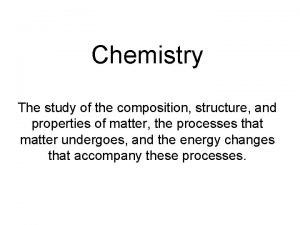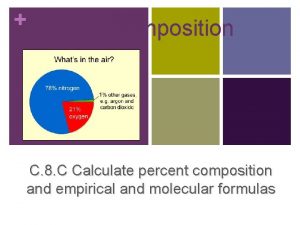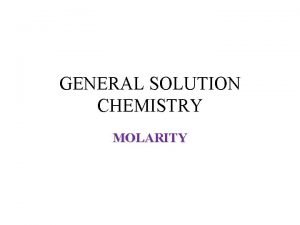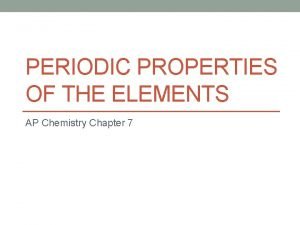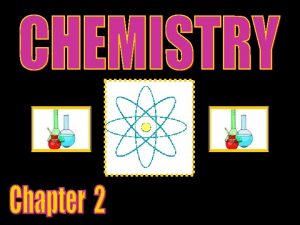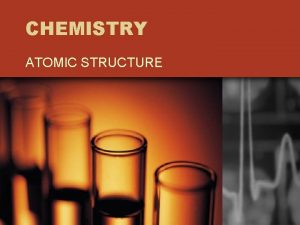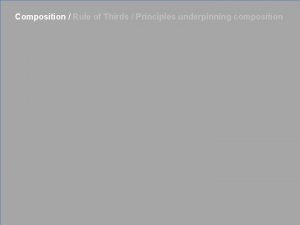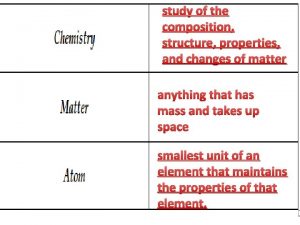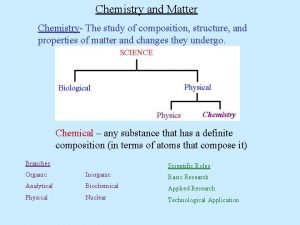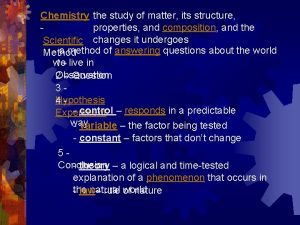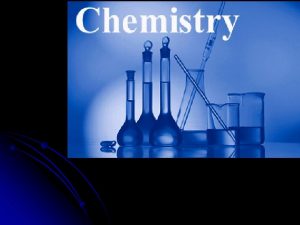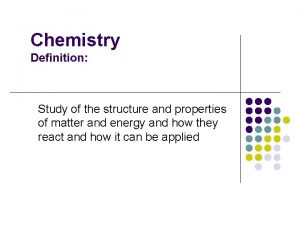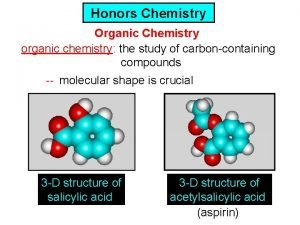A Chemistry study of the composition structure properties


























- Slides: 26


A. Chemistry = study of the composition, structure, properties, and reactions of a substance. • Life depends on chemistry. . . Because chemical compounds are the building blocks of life.

ØNOTE: MASS= Mass vs. weight animati on The quantity of matter an object has. MASS AND WEIGHT ARE NOT THE SAME!

1. Definition= basic unit of matter 2. Atoms are composed protons(+), neutrons(0), and electrons(-) 3. Protons and neutrons are located in a central area called the nucleus. 4. Electrons move about the nucleus. The # of electrons is equal to the # of protons.

1. Definition = a pure substance that contains only one type of atom 2. About 96% of the mass of all kinds of living things is composed of a combination of just 4 elements…

Image from: http: //www. sciencelearn. org. nz/Contexts/Just-Elemental/Sci-Media/Images/Elements-in-the-human-body


3. Periodic Table—developed as a way to organize elements Ø Elements found in order of atomic number (# of protons) ØAtomic weight (# of protons + # of neutrons) get bigger as you go across and down ØPeriods of elements = rows ---As you go across a row, elements get smaller in size BUT greater in mass ---Example: The go from a beach ball to a bowling ball Ø Groups of elements = columns Elements in the same group have similar properties and will bond in similar ways

PERIOD = Row GROUPS/FAMILIES = Columns As you go L to R across a period PERIODIC TABLE Atomic size decreases and atomic mass increases

Information gathered from the PERIODIC TABLE 2 He Helium 4 **Harry Potter Elements Song** Atomic Number Chemical Symbol Element Name Atomic Mass

2. Remember mass number = number of protons plus neutrons in nucleus of atom Example: carbon-12, carbon-13, carbon-14 Carbon – 12 Carbon – 13 Carbon – 14 # protons 6 6 6 # neutrons 6 7 8

PERIOD = Row GROUPS/FAMILIES = Columns As you go L to R across a period PERIODIC TABLE Atomic size decreases and atomic mass increases

MOST elements do not exist by themselves. . . 1. Definition: a substance formed by the bonding of two or more elements in definite proportions 2. Chemical formula = shows the composition of the compound Ø Examples: H 2 O, Na. Cl, CO 2 3. physical and chemical properties of compound are DIFFERENT from each element alone

G. Bohr Models of Atoms 1 st electron shell can hold— 2 electrons 2 nd electron shell can hold— 8 electrons 3 rd electron shell can hold— 8 electrons ØExamples: Hydrogen (1) Oxygen (8) Carbon (6) Chlorine (17)

Hydrogen Carbon Chlorine Oxygen

1. Definition= the forces that hold together the atoms that make up compounds 2. Two main types of STRONG chemical bonds: 1= ionic bonds 2= covalent bonds. . . Let’s take a look at each type more closely. .

1. Ionic bonds ---a TRANSFER of electrons takes place resulting in ions ---ion = a positively or negatively charged atom ---ions of opposite charge attract strongly, thus forming an ionic bond

Example: Na. Cl The number of electrons in outer energy shell determines the chemical properties of an atom. **Atoms want their outermost shell to be full**

When sodium chloride (Na. Cl) is formed, one electron from sodium is transferred to chlorine.

**Ionic Demo**

2. Covalent bonds ---involves SHARING of electrons ---single covalent bond =share one electron ---double covalent bond = shares 2 electrons --result of covalent bond = a molecule. . . which is the smallest unit of a compound --Example: Methane (CH 4) **Covalent Demo** click through tutorial reading 1 -14, 22 -24, and 30

In a double bond, 2 atoms share 2 pairs of electrons (4 electrons) O 2

In a triple bond, 2 atoms share 3 pairs of electrons (6 electrons) N 2

Sharing of electrons between two Oxygen atoms

Structure of the 4 elements that make up most of the mass of living things:

 The study of composition structure and properties of matter
The study of composition structure and properties of matter Atomic structure and properties ap chemistry
Atomic structure and properties ap chemistry Percent composition examples
Percent composition examples Functional groups ib chemistry
Functional groups ib chemistry Inorganic chemistry vs organic chemistry
Inorganic chemistry vs organic chemistry What is the molarity of a solution
What is the molarity of a solution Ap chemistry chapter 7 periodic properties of the elements
Ap chemistry chapter 7 periodic properties of the elements Extensive examples
Extensive examples Is smell a physical property
Is smell a physical property Hát kết hợp bộ gõ cơ thể
Hát kết hợp bộ gõ cơ thể Slidetodoc
Slidetodoc Bổ thể
Bổ thể Tỉ lệ cơ thể trẻ em
Tỉ lệ cơ thể trẻ em Voi kéo gỗ như thế nào
Voi kéo gỗ như thế nào Tư thế worm breton là gì
Tư thế worm breton là gì Chúa sống lại
Chúa sống lại Kể tên các môn thể thao
Kể tên các môn thể thao Thế nào là hệ số cao nhất
Thế nào là hệ số cao nhất Các châu lục và đại dương trên thế giới
Các châu lục và đại dương trên thế giới Công thức tính độ biến thiên đông lượng
Công thức tính độ biến thiên đông lượng Trời xanh đây là của chúng ta thể thơ
Trời xanh đây là của chúng ta thể thơ Mật thư tọa độ 5x5
Mật thư tọa độ 5x5 Phép trừ bù
Phép trừ bù Phản ứng thế ankan
Phản ứng thế ankan Các châu lục và đại dương trên thế giới
Các châu lục và đại dương trên thế giới Thể thơ truyền thống
Thể thơ truyền thống Quá trình desamine hóa có thể tạo ra
Quá trình desamine hóa có thể tạo ra
